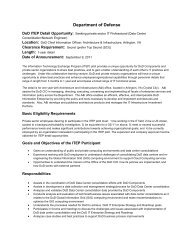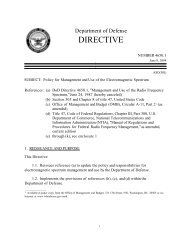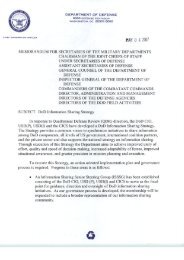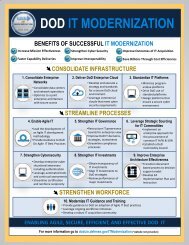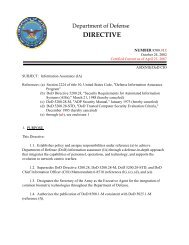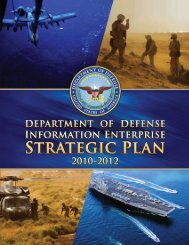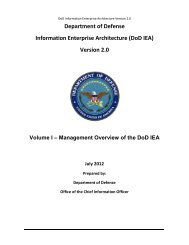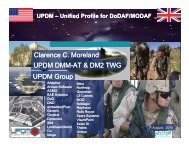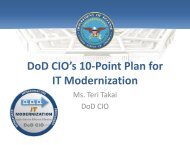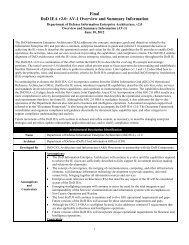DoD Architecture Framework Version 1.5 - Chief Information Officer
DoD Architecture Framework Version 1.5 - Chief Information Officer
DoD Architecture Framework Version 1.5 - Chief Information Officer
You also want an ePaper? Increase the reach of your titles
YUMPU automatically turns print PDFs into web optimized ePapers that Google loves.
architecture federation, net-centricity, executable architectures, and the full range of DOTMLPF<br />
alternatives.<br />
One critical component for the development of <strong>DoD</strong>AF v2.0 is an architecture conceptual<br />
data model that provides a semantically complete, tool and methodology independent, holistic,<br />
“architect’s view” for describing integrated <strong>DoD</strong> architectures. An “architect’s view” is an<br />
architect’s view in formalizing and expressing an architecture description, and is independent of<br />
modeling technology (structured or object-oriented) and source (i.e., commercially available<br />
enterprise architecture tools and/or government developed applications). One example of an<br />
approach for this architecture conceptual data model consists of a small, yet powerful, set of<br />
descriptive concepts and a taxonomy for the <strong>DoD</strong> architecting community of interest that groups<br />
architectural elements according to six interrogatives – WHO, WHERE, WHAT, WHY, WHEN,<br />
and HOW. Together, these serve as a foundation for meeting new requirements and demands on<br />
future integrated <strong>DoD</strong> architecture usage.<br />
The goals of this next generation <strong>DoD</strong>AF are to (1) address current <strong>DoD</strong>AF limitations,<br />
weaknesses, and deficiencies; (2) provide a data-centric approach to building, implementing, and<br />
using integrated architectures; (3) enable “federation” of architectures; (4) capture sufficient<br />
architectural detail for full DOTMLPF analysis; and (5) provide support for architecture-based<br />
analysis and assessments that link directly to mission outcomes and objectives for the <strong>DoD</strong> core<br />
processes.<br />
2.4 DEVELOPMENT OF INTEGRATED ARCHITECTURES AND FEDERATED<br />
ARCHITECTURES<br />
2.4.1 Why Develop <strong>Architecture</strong>s that Support Integration and Federation<br />
The ability to integrate and/or federate architectures is essential for addressing enterprise<br />
issues across a broad domain such as the <strong>DoD</strong>. It enables multiple groups to develop<br />
architectures with the focus that best meets their immediate needs, while providing a means for<br />
linking and relating those architectures to address issues that cross multiple areas. A single<br />
architecture cannot sufficiently address the entire <strong>DoD</strong> and its diversity of missions to where all<br />
of the various types of analyses, enabled by the architecture construct, are supported. The ability<br />
to integrate and/or federate multiple architectures leads to a more robust construct for<br />
understanding the enterprise. Policies pertaining to the GIG are currently being updated to<br />
include specific direction on architecture, a portion of which reinforces this federation concept.<br />
Integrating and/or federating architectures become necessary in a NCE. It plays a significant<br />
role in both the development of the environment and the sharing of information. As the <strong>DoD</strong><br />
becomes increasingly networked, integrated and/or federated architectures become essential in<br />
organizing the vast array of information and complex relationships. As an example, the<br />
realization of the GIG will be accomplished through GIG Capability Increments. These<br />
increments will define IT Capabilities to be achieved in a specific period of time. Federated<br />
architecture data can be used to evaluate portfolios of existing systems and programs to make<br />
decisions about changes or additions necessary to achieve the IT capabilities in each increment.<br />
2.4.2 Development Considerations for Integrated <strong>Architecture</strong>s<br />
In order to develop integrated architecture descriptions, commonality in the entities or<br />
objects represented in multiple views, and the relationships between those entities or objects<br />
must be captured in the underlying data model. Examples of important commonalities include:<br />
2-5




